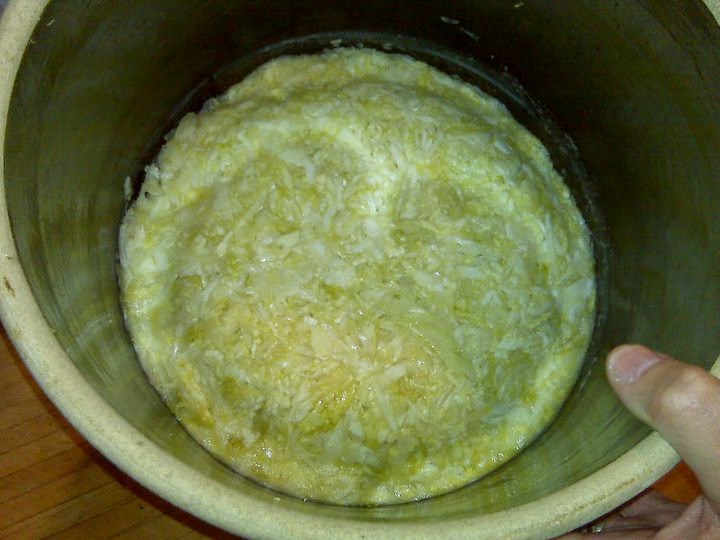The fermentation process takes a few weeks. Be aware the aroma of fermenting vegetation can waft throughout the house. I try to close off the crock in a spare room or a cool basement to minimize the odor. If I have enough cabbage, I ferment 50 pounds at a time, which requires a five gallon crock. I've also had success fermenting a smaller batch (25 pounds of cabbage). I tend to avoid ferment-in-the-jar recipes. I think a large batch of fermenting cabbage has a better flavor. If we make more that what we'll eat, my friends and family enjoy the excess.
 |
| I ferment the cabbage in a five gallon, lead-free crock. Other non-reactive containers suitable for curing include food grade plastic, glass or stainless steel. |
 |
| Discard outer leaves and cut into quarters. Remove core. |
 |
| Fermentation will be complete in 3-6 weeks. The cabbage will be wilted and yellow. |
 |
| Remove kraut from crock to a large stock pot. Bring just to a simmer. Pack hot kraut into jars and process quarts for 20 minutes in a boiling water canner. |
 |
| Allow to cool for 12 hours. Remove rings, wipe down jars and store in a cool, dark place. |
Sauerkraut
from Ball Blue Book
50 lbs cabbage
1 pound canning salt
Wash and drain heads. Remove outer leaves, cut heads into quarters and remove core. Use a shredder or sharp knife to cut cabbage into thin shreds. In a large clean, lead-free crock, thoroughly mix 3 Tbsp salt with 5 lbs cabbage and let stand for several minutes to wilt slightly. This allows packing without excessive breaking or bruising. Using hands, press down firmly until juice comes to the surface. Repeat shredding, salting and packing until all cabbage and salt is used. If juice does not cover cabbage, make a bring by boiling 1 1/2 Tbsp salt and 1 quart of water. Cool before using.
Cover cabbage with cheesecloth, tucking edges against the inside of the crock. Weight cabbage under brine by placing a dinner plate over cloth (add additional weight on top of plate, if necessary). Formation of gas bubbles indicates fermentation is taking place. Remove and discard scum formation each day. A room temperature of 70-75 degrees F is best for fermenting cabbage. Fermentation is usually complete in 3 to 6 weeks.
To can:
Bring kraut to a simmer (185-210 degrees). Do not boil. Pack into hot jars leaving 1/2-inch headspace. Ladle hot brine liquid over cabbage leaving 1/2-inch headspace. Remove air bubbles and adjust lids. Process pints 15 minutes, quarts 20 minutes in a boiling water canner. Yield: 18 quarts



